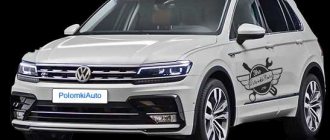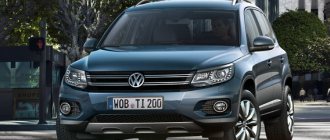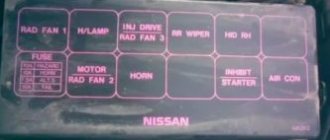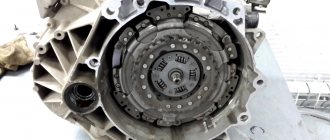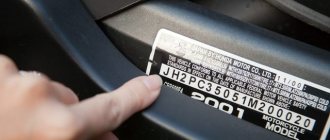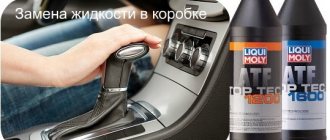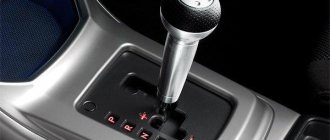Thanks to cars like the Volkswagen Tiguan, people have become accustomed to the fact that everything new, complex and advanced must require additional investment, as a tribute to the opportunity to experience modern technologies. It’s a pity that not all applicants for used cars realize that they are choosing the difficult fate of technocrats.
Maybe that’s why people don’t line up for supported Tiguans like they do for a new iPhone. Because of this, there is a loss of liquidity from year to year and, accordingly, an inexorable decrease in value. In principle, for Volkswagen lovers the picture is already familiar, as are piston repairs at 40 thousand km, early wear of the chain, turbine, and electrical problems. So let's figure out whether Tiguan's reputation is so bad that we should turn our nose up at used options or do we just need to understand the engines?
It is difficult to call either the chain or gears of Tiguans “eternal”. As you can see, some parts are made in China
Choose your problem
Unlike the co-platform Skoda Yeti, the Volkswagen Tiguan never saw a naturally aspirated 1.6 engine, and the entire line of high-performance turbocharged units was overgrown with sensitive, if not intimate, problems. The most expensive “disease” of gasoline engines turned out to be burnout of pistons and melting of their partitions. Needless to say, the ones that were most often rebuilt were the 1.4 engines “inflated” to 150 hp, the same ones that won awards due to their characteristics. After numerous complaints, the mechanical compressor was removed from the unit, leaving 122 hp (CAXA) alone with other typical problems of VW gasoline turbo units.
For Tiguan owners this is already a typical picture. Burnt-out piston, crumbled ring partition
There were quite a few weak points in the entire line; I suspect there would be even more of them if the 1.2 TFSI was installed not only on the Yeti, but also on the Tiguan. Pumps flow with bitter tears for the former German quality, exhaust manifolds crack painfully, stretched chains clatter, turbines whistle at the engineers who laid such a low resource. Problems with the EGR valve and air pressure in the manifold are perceived as commonplace. Half of the used Tiguans inspected had faults in the crankcase gas circulation system.
Features of factory assembly. The nut came loose and damaged the impeller. Replacement insert
Why is 2 liters better?
In the top-end 2.0 engine (CAWA, CAWB), cases of burnout of “standard” pistons are less common; the upgraded parts generally hold up as they should. But in small things the engine can be no less burdensome. For example, ignition coils are used to “dying” not one at a time, but 2-3 at a time, that is, high-quality fuel and short replacement times for spark plugs will help save your budget.
In fact, there are two problems in this photo: 1. The manifold has burst 2. The pressure regulator is worn out, the ringing of which can be heard at “boost” speeds
Large financial investments are not required to eliminate them in case of wear of the turbine actuator, which is usually indicated by a ringing sound and is accompanied by errors in “underblowing”. Tiguan owners are accustomed to repairing the “under-pumping” injection pump of a 2-liter engine themselves, making do with replacing the pusher, after which the pressure in the system returns to normal. When something like this happens on a diesel version, owners usually clutch their hearts.
Such deposits in the intake manifold and on the throttle valve are typical for all cars that have not yet disabled the ERG valve. Periodic cleaning is required
But in cars running on diesel fuel, the chain does not stretch, since the timing drive is belt driven and, according to regulations, changes every 90 tkm. Diesel units, in principle, turned out to be more durable, but at the same time less adapted to Russian winters, which in principle is logical. Problems usually arise when launching into deep negative temperatures.
Malfunctions of the intake manifold flap are usually eliminated independently
Guarantee
| Guarantee | Period |
| For repair of the control unit / mechatronics | 12 months |
| For hydraulic unit repair | 1 year |
| For repair of automatic transmission, DSG, CVTs | 1.5 years |
| From 1 to 3 days | All spare parts are in stock | Free diagnostics |
| Procedure for automatic transmission repair |
|
DSG and Haldex all-wheel drive
Fortunately, the remaining components of the Volkswagen Tiguan decently smooth out the overall picture of the car and allow us to pull, as it might seem at first glance, a C-grade student to a higher rating in the chain of our reviews. For example, the “automatic” 09G, apart from periodic replacement of the rubber bearing and oil, does not require anything for a long time. There is nothing to say about the manual transmission; there are no questions about it at all. Interestingly, the manufacturer decided to play it safe and did not install its over-praised DSG on the Volkswagen Tiguan before the restyling. Only in 2011, a 6-speed “robot” with wet clutches was paired with a 1.4-liter line and they were right, there simply weren’t as many angry reviews as the DSG-7 was to its liking.
The outboard bearing will live longer if you do not abuse the terrain and monitor the presence of lubrication
And, again, it is worth paying tribute to the 7-speed robot, with a proper approach to maintenance and competent driving style, it is capable of withstanding 150 thousand kilometers of mileage without replacing clutches. It’s a pity that the cat cried for such owners. Much more often there are those who, on the contrary, use the modest resource of units to the fullest.
The Haldex coupling pump is at risk for those who neglect to change the oil in the unit and like to anneal with slippage
The same applies not only to the dynamic capabilities of the car, but also to its off-road qualities. As it turned out, many owners who overestimated the terrain manage to break through the transmission pan, protected by standard “foil”, called protection in car dealership orders. However, forays into the mud are also contraindicated for the Tiguan, as you risk overheating the Haldex of the all-wheel drive. The clutch already suffers from chronic hydraulic pump failures. Generally speaking, change the oil in your gearboxes on time, don’t drive it too fast, and you will be happy.
A car with a monocoque body and an electric fluid coupling will be able to pass diagonal hanging, but at your expense
Which Tiguan is richer inside?
The seven-seater version of the Volkswagen Tiguan appeared only in the second generation - the first generation is equipped with five seats. The driver and passengers feel comfortable even on long trips. Fortunately, the front seats and steering wheel have a sufficient number of adjustments.
The trunk may seem scanty - only some 470 liters with the backrests of the rear sofa raised. However, if they are lowered (they fold in a 40/20/40 ratio), the volume can be increased to 1,510 liters. If you also fold down the front passenger seat, you can safely load the interior doors into the car.
The top-end equipment of the pre-restyling crossover will delight you with a climate system, four airbags, and heated front seats. Options such as cruise control, bi-xenon optics and leather interior trim were offered at an additional cost.
The updated Tiguan in the most expensive version has twice as many airbags, an assistant when starting up or downhill, rear parking sensors, dual-zone climate control, a cooled glove box, driver fatigue monitoring, light tinting of windows and a lot of other bells and whistles "
Also read: An underrated car with one huge problem: review of the Peugeot 3008 1st generation
Golf platform
There are almost no weak points in the chassis. Even the service life of stabilizer struts of 60-70 thousand km can be considered respectable. The front torsion bar bushings last a little longer, but repairs at dealers only mean replacing the entire system assembly. In order to save money, you will have to buy rubber bands from Opel and go to a third-party service. The next items to arrive, as a rule, are the wheel bearings and the rear silent blocks of the front arms. It is better to immediately change both in pairs, since their service life is approximately the same - 80-100 thousand km. Everything else, including shock absorbers, usually lasts much longer, and there is no point in planning a major overhaul of the chassis before 150 tkm.
The shock absorbers are extremely durable, they can easily cover 150 tkm
In general, everything is fine with the brakes, the main thing is to make sure that the ABS unit has the latest firmware version, otherwise the Tiguan can “stretch” forward considerably when braking sharply on an uneven section. The steering sometimes requires intervention, but mostly not even because of the tips, but because of failures in the electrical part. For example, oxidized and damaged EUR contacts can be costly. Just one of the Tiguans we examined required replacement of the entire assembly. The warning light on the dashboard was turned off, but the gain itself seemed very suspicious, as it happened jerkily. Of course, computer diagnostics produced a string of errors with system malfunctions.
In this photo, one problem has been fixed (the silent block of the lever is already new), and the second, unfortunately, can no longer be fixed - the car was severely damaged in an accident
The electric drive of the hand brake also sometimes mopes, especially in the cold season, when the driving mechanisms are constrained by moisture. Because of this, the drive motor may need to be replaced. In frosty weather, as a rule, crickets wake up and have a completely standard location in the area of air duct deflectors and elements of the center console, which is not made of the softest plastic.
An attempt to “eliminate” crickets in the panel ended in the deflector breaking. Plastic is cheap in places
Strange automatic transmission on a diesel engine - logbook of the 2012 Volkswagen Tiguan TDI on DRIVE2
I noticed some oddities in the operation of the automatic transmission. They bother me as an experienced manual transmission driver, but my wife drives and doesn’t really bother. Nevertheless, diesel + automatic transmission is considered the most reliable and problem-free combination in the VAG line, and this modification of the Tiguan is in great demand on the market for those in the know.
1. This is the automatic transmission nodding when braking the engine, noticeable from 4 to 3, less noticeable from 5 to 4. Neither the automatic transmission firmware, nor the change of coding, nor the oil change changed anything. Trailer stabilization is disabled. Most likely this happens because the automatic transmission pushes down the gearbox when braking already at 1500 rpm, and when switching to a lower one, the speed is already above 2000, you get a dive and intense engine braking (diesel engines have high compression)... Judging by the forum, everyone has this ...
I recently drove a Volvo XC-90, it has an 8-speed automatic... so, when braking, the shifts are completely imperceptible, the shift occurs at 1000 rpm, and the lowest gear has 1300 rpm after switching, so at such speeds there is no intense engine braking...
2 For example, I’m driving 70-80 in 6th gear without accelerating, I sharply press the gas to the floor, the gearbox jumps to 4th and without a kick the car starts accelerating in 4th...
And if I drive the same 70-80 and press the gas by 50%, the car accelerates to 6th pressure, then I press the gas all the way, the box jumps to 4 and there is already a decent kick and then acceleration... is this also a feature of the automatic transmission? Not a very pleasant moment... That is, under the influence of high torque from 6 to 4 a kick occurs... if you hit the gas sharply while driving evenly, then switching to 4 and subsequent acceleration occurs comfortably
3 It looks like the gear ratios for gasoline and diesel are the same for these boxes. at 120 km/h the speed is somewhere around 2500 rpm in 6th gear, when for example a diesel Touareg with automatic transmission 8 at 180 km/h is the same 2500 rpm. In general, this bothers me the least because 90% of the driving around town. and on the highway up to 140 km/h, mostly, a 2-liter diesel engine is not conducive to racing
www.drive2.ru
Permanent all-wheel drive is absolutely necessary when driving off-road. On paved streets, intelligent all-wheel drive increases active safety. The Tiguan uses the latest generation of 4MOTION all-wheel drive. It shifts manually or has an optional six-speed automatic transmission.
4MOTION improves the safety and ease of driving of the Tiguan.
In 1998, Volkswagen first introduced the more advanced 4MOTION all-wheel drive transmission, which was a successor to the earlier “syncro” system. For the past decade, the concept of all-wheel drive transmission has been developing and complemented by new technical solutions. A special feature of the 4MOTION system, which was installed in the model segment up to the Passat V6 FSI (different technology is used in the Phaeton and Tiguan models), is the Haldex clutch, which has a very high response speed. The latest generation of this system has found its application in the Tiguan model.
When creating the Tiguan, engineers sought to develop an all-wheel drive transmission that could provide high dynamics, safety when driving on roads and the best traction off-road. This goal was achieved without increasing fuel consumption, negatively affecting the engine or increasing noise generation.
Discuss on the forum
www.tiguans.ru
Tiguan with 100 thousand km mileage
The appearance of the interior is not lost as quickly from year to year as, for example, in the budget Polo Sedan, but fabric seats also get dirty easily, and pseudo-leather seats can crack at the folds after 100 thousand km. Although in general, even after 100 thousand km, the Tiguan can look very fresh, which is often taken advantage of by dishonest sellers who “twist” the mileage. Fortunately, information about the path traveled is stored in many control units. From my own experience, I will say that even these readings should not be trusted; it is still better to rely on the condition of the car and take into account many indirect signs.
This car's mileage in the engine ECU is significantly different from what is stated.
As has already been said, after the first “hundred” the Tiguan retains its original appearance quite well, but this is the danger of the purchase, because a car that seems well-maintained at first glance is often technically already “dying.” This is especially true for cars with a 1.4 engine. In almost all copies, no matter which engine you choose, after a mileage of 100 thousand km the turbine is already covered with a “coat” of oil leaked into the manifold, and there are also problems with the circulation of crankcase gases. For some reason, the rear silent blocks of the levers are always in a shabby state.
Many people did not like the standard multimedia system, but third-party head units do not want to be friends with the multifunction steering wheel
With rare exceptions, there are usually no problems with other components and systems, but almost all of the specimens inspected before purchase, even very fresh ones, have “repaints” on the body. It is difficult to say what this is connected with; most likely, with dynamic capabilities. One way or another, the Tiguan is afraid of corrosion, but not much; the bare metal is only covered with a reddish film without further spread. The only exception is the seams under the windshield molding.
Corrosion for Tiguan is rare, but quite real
Which Volkswagen Tiguan to choose: before or after restyling
The updated first generation Tiguan differs from its predecessor not only in appearance. The restyled version has more engines, transmissions, options and fewer problems. It makes sense to dwell on it. At a minimum, if only because the pre-reform Tiguans are already 8-12 years old.
The Volkswagen Tiguan is perfect for those who live mainly in the city, but sometimes drive off good asphalt. The car will perfectly cope with the role of a family car, given its spaciousness and relative efficiency. But this does not mean that he is devoid of ambition and fervor. Older modifications with “peppy” engines can give the driver unforgettable emotions. So young and active drivers may take a closer look at them.
Author: Kristina Izvekova
Which Tiguan would you choose and why? Write in the comments.
Choosing Tiguan
As we can see, a used Volkswagen Tiguan is quite dangerous, especially if we are talking about a car with over a hundred miles. Naturally, the “killer” regulations, driving style and fuel quality played a big role in the deterioration of the reputation. Therefore, it is possible to find a properly maintained car, but it is better to abandon versions with a 1.4 engine altogether, at least the 150-horsepower modifications for sure. Among 2.0-liter units, the least “inflated” one would be preferable, and even better, a diesel engine paired with a hydraulic automatic transmission or manual transmission. As is the case with many other “Germans,” any used Tiguan requires mandatory computer diagnostics when checked before purchase. Albeit with a degree of error, it is still possible to assess the condition of the chain, the remainder of the “robot” clutches, identify possible faults in the power steering, etc.
The interior of the Tiguan is able to maintain its original appearance for a long time. All cars tested before purchase had no problems with this.
Bringing everything to a common denominator, we come to the conclusion that with a competent approach to choosing a car, even a used Volkswagen Tiguan should not require large investments. The most desirable options are cars that have already been to the dealer for a capital stock, since the pistons and chain are being replaced with modernized, reinforced ones. However, I am still haunted by the thought that we have come to a time when low-mileage SPG repairs have become the norm for Volkswagen.
Why are DSG boxes dying? ZR research
We listened to Volkswagen technical specialists and collected information from unofficial service stations specializing in the repair and maintenance of DSG robotic gearboxes - and we are ready to give an answer.
The first cars with DSG robots appeared in Russia in the early 2000s. During this period, the units underwent many finishing operations. Let's take a closer look at how the latest modifications of the two main representatives of the DSG family, which are considered not the most reliable, have performed.
Location of VIN and engine number
The main VIN number of the Tiguan is located on the right “cup” under the “jabot” and can be accessed after removing one clip and removing the plastic cover. Duplicate markings are located under the windshield and on the left center pillar sticker. By the way, you can use the latter to find out the engine model. But the number of the power unit itself is located inconveniently - in the front part of the cylinder block at the junction with the gearbox. Access to it is blocked by a mass of wiring harnesses and pipes. The data is duplicated on a sticker on the left side of the engine on the plastic casing near the expansion tank, the only thing is that you shouldn’t trust this piece of paper 100%.
The VIN number will not be difficult to find, but you will have to look for the engine markings and sometimes you cannot do without partial disassembly
